Table of Contents
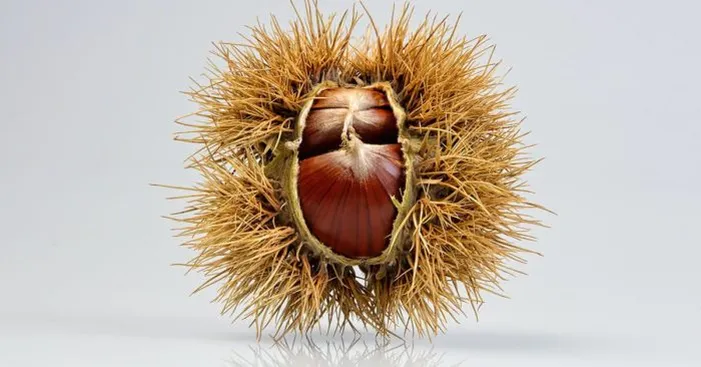
Chest nuts are one of the most amazing nuts both in terms of deliciousness and nutritional composition.
Also, every part of the chestnut tree can be used from flowers, leaves, fruits, and even wood.
In this article, we gathered all the information you need to know about chest nuts, the edible types, the useful parts of a chestnut tree, the nutritional values, and possible side effects of chest nuts, alongside tips on how to buy + cook + store them.
Chest nuts: overview
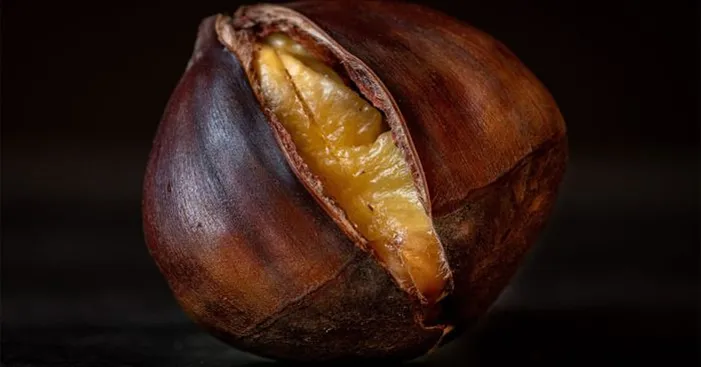
Commonly coming from the family of beeches Fagaceae, chestnut trees come in many types and they produce crunchy nuts.
Chest nuts grow all around the world and they are considered both fruits and vegetables depending on the type.
For instance, the famous European horse chestnuts are part of the lychee family Sapindaceae.
On the other hand, water chestnuts grow on the grass around lakes throughout Asia and they are considered a water vegetable.
Botanically, fruits are the product of a flowering plant and they contain seeds inside of them.
We can regroup nuts into three main categories based on the botanic standards:
- Fruits: Hazelnuts and chest nuts.
- Seeds: Walnuts, cashews, pistachios, pecans, pine nuts, and almonds.
- Legumes: peanuts.
This is because chest nuts and hazelnuts are fruits themselves while the other common nuts are basically the seeds of the fruits.
As for the taste, chest nuts have a crunchy texture that can be tenderized after roasting or cooking.
The best thing about chest nuts is that they have a slightly sweet flavor that combines very well with a long list of recipes.
Difference between chest nuts and “crazy chest nuts”:
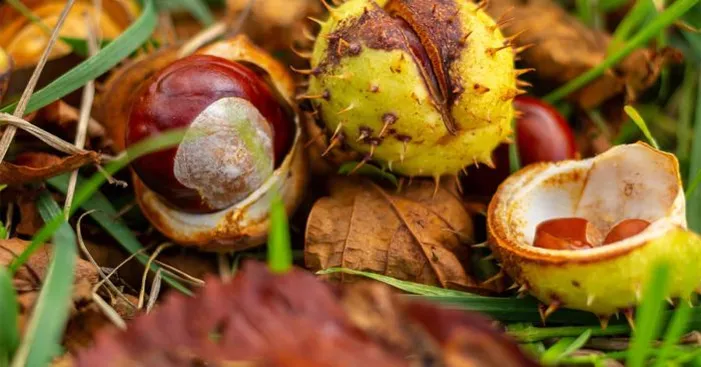
It can be tricky to differentiate between edible chest nuts and other similar varieties.
In fact, there are two types of trees that produce similar fruits the edible chestnuts and other fruits that can be even poisonous.
The Fagaceae family:
Trees belonging to this family are known as Castaneae Sativa and they produce delicious nutty chest nuts.
The leaves of these trees come in a simple form and the fruits are covered in a spined capsule that resembles hedgehogs.
However, the capsule and the spines are soft and green when the fruit is unripe but turns hard and brown once they ripen.
The Sapindaceae family:
The trees belonging to this family are called Aesculus Hippocastanum and they generally produce poisonous fruits.
They are characterized by large leaves and produce green-spined fruits known as “crazy chest nuts” due to their toxicity.
As mentioned above, one of the most known poisonous chestnuts is the “horse chestnut” and you must leave it on the ground if you see it.
Types of edible chest nuts:
There are many types of chest nuts but we are only going to be focusing on the edible ones.
This nutty fruit ripens between October and December which makes it the best time to get fresh chest nuts.
Generally, there are 4 edible types of chest nuts known as Castanea dentate, Castanea crenata, Castanea Sativa and Castania Mollisima.
Each of these variants produces different edible subtypes with the most famous ones being:
Castanea Sativa:
This Spanish variety is the most cultivated in Europe and offers some amazing subtypes including:
Olargues: mainly grown in France, this type of chest nut comes in a medium size.
Comballe: also grown in France, comes in medium-large size and ripens in late November.
Belle Epine: another French type is known for its large size.
Bournette: a hybrid variety between Castanea sativa and Castanea crenata and comes in a medium-large size.
Castanea crenata:
This type is native to Japan.
Castanea Mollisima:
First originated in China, this type is well-praised for its fragrant flavor.
Castanea Dentata:
This is the most cultivated type across North and South America and is sometimes even called “American chest nuts”.
Chest nuts nutritional values and health benefits:

Nutritional values:
It is not advised to consume raw chest nuts as they may contain harmful substances.
However, consuming roasted chest nuts is very beneficial for our health.
Nutritionists recommend consuming a handful of 10 kernels a day to get the most out of these fruits in a safe way.
With 3 ounces of chest nuts a day your body will be getting only 200 calories while getting a boost in many essential nutrients.
For instance, chest nuts are a good source of vitamin C (25%), B6 (25%), B1 (17%), and B9 (15%).
In addition, they are full of minerals including copper (48%), manganese (44%), and potassium (11%).
Chestnuts contain coumarin, fatty oil, triterpene, tannins, starch, sterols, fatty acids, …
They are also a good source of flavonoids including quercetin, kaempferol, and isoquercetin which are powerful antioxidants.
The good thing about chest nuts is their low-fat content compared to other nuts like walnuts and almonds.
However, they are full of nutrients and they are very satisfying which makes them one of the healthiest nuts.
from the B group.
These nutritional data counts for a serving of 3 ounces (10 kernels, 85g) of roasted and chest nuts:
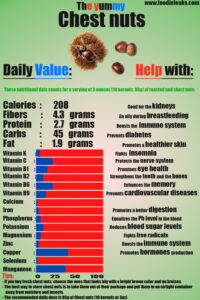
- Calories: 208
- Fibers: 4.3g
- Protein: 2.7g
- Carbs: 45g
- Fat: 1.9g
- K vitamin: 6%
- C vitamin: 25%
- B1 Vitamin: 17%
- B2 vitamin: 11%
- B6 Vitamin: 25%
- B9 Vitamin: 15%
- Calcium: 2%
- Iron: 4%
- Phosphorus: 7%
- Potassium: 11%
- Magnesium: 7%
- Zinc: 4%
- Copper: 48%
- Selenium: 2%
- Manganese: 44%
Health benefits:
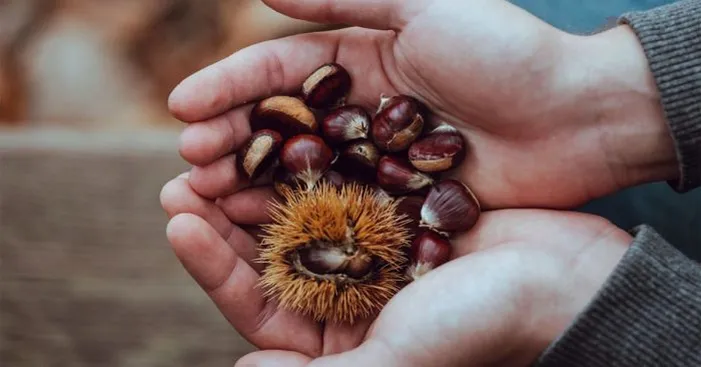
Good for kidney failure:
Kidneys are one of the vital organs that our bodies need to constantly filter out the toxins in the blood.
In case of kidney failure, the body will experience a sudden rise in acidic substances like uric acid in the blood.
This is where chest nuts come in handy, these nuts provide good amounts of potassium and water.
With such nutrients, the body has a better chance of alkalizing the acidic effect caused by kidney malfunctions.
In other words, the nutritional profile of chestnuts has the ability to neutralize the acids in the blood.
This can reduce the body’s dependency on the kidneys to equalize the PH level in the blood.
Also, chest nuts offer a high amount of energy with a fairly low protein content which is favorable in case of kidney failure.
An ally when breastfeeding:
As part of a lifestyle for nursing moms, chest nuts can act as a natural galactagogue alongside other medicines.
Galactagogues are basically substances that aid in the production of breast milk to help meet the daily requirement of the baby.
This is still the subject of many studies, but people all around the world use chest nuts traditionally to increase breast milk.
Boosts the immune system:
Chest nuts are a good source of vitamin C and many other antioxidant components which makes them a good natural immune booster.
Vitamin C is one of the best natural antioxidants that help the body fight free radicals and eradicate them before they cause any harm.
This mineral also enhances the production of white blood cells which are the tools needed to provide immunity.
Helps prevent diabetes:
Whenever we think of diabetes, we instantly link it to glucose and insulin levels.
That is partially correct, but we should also be thinking about the amount of daily dietary fiber we get.
A lot of studies show the great effect of fibers in stabilizing blood sugar levels which is beneficial for diabetic patients.
This is why chest nuts are a major ally to diabetic patients and can even help prevent diabetes when we don’t have it.
For instance, these nuts contain a good amount of dietary fiber while being considered a low glycemic food.
It should be noted that low glycemic food means that they cause a slow rise in blood sugar levels.
In other words, consuming chest nuts reduce the risk of blood sugar spikes which is dangerous for people with or without diabetes.
other benefits of chest nuts:
- Promotes healthier skin.
- Protects the nervous system.
- Fights insomnia.
- Promotes lung and eye health.
- Strengthens teeth and bones.
- Prevents cardiovascular problems.
- Stimulates and enhances memory.
- Helps promote better digestion.
Other useful parts of the chestnut tree:
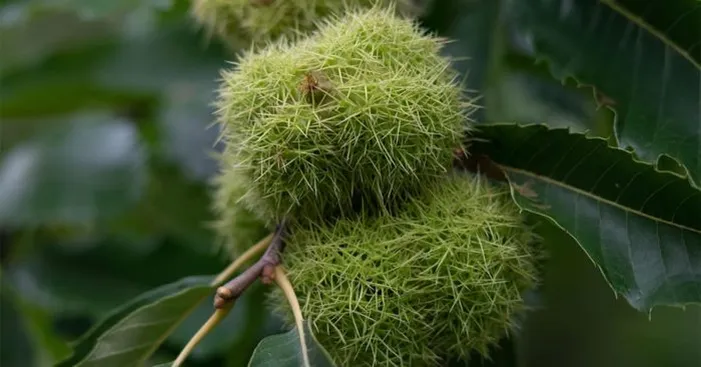
Chestnuts flowers:
Especially in China, people use chest nuts flowers in traditional medicine as they believe it has many health virtues.
They pick fresh flowers during spring and use them in their healing recipes or they dry them for usage in the future.
The flowers of a chestnut tree are a good natural treatment for fever, irritability, and dehydration.
Also, these flowers can also activate the blood and reduce swelling which can significantly promote wound healing.
Chinese also use chestnut flowers as a treatment for diarrhea and stomach bloating.
In recent years, many scientists conducted a series of studies to confirm these beneficial aspects of the chestnut flowers.
Chest nuts leaves:
In addition to the rich nutritional composition of the fruits, the leaves of a chestnut tree also have a lot of medicinal properties.
This explains why we can find these leaves in traditional medicine practices across the world.
Among the usage of chestnuts leaves we mention:
- In cosmetics: the leaves of the poisonous horse chestnut are sometimes used as the main ingredient for anti-aging skin creams.
- Herbal teas: these drinks made from chestnut leaves are believed to have hypotensive properties and a relaxing effect.
The do’s:
Make a drink using chestnut leaves and hot water and use it to:
- Treat varicose and hemorrhoids.
- Relieve fatigue.
- Prevent liver diseases.
- Treat circulatory system diseases.
The don’ts:
There are some rules you should stick to avoid any possible effect that can be caused by chestnut leaves tea:
- Avoid giving it to the elderly and children.
- Do not use it excessively as it can cause itching, vomiting and other unwanted symptoms instead stick to 1 cup per day.
Precautions before you consume chest nuts:

People with spleen deficiency must stay away from raw chest nuts and rather consume them roasted or stir-fried.
Despite its anti-diabetic properties, people with diabetes should only consume chest nuts moderately as they contain a lot of carbs.
Also, pregnant women and kids with constipation problems should not consume chest nuts as they may cause health degradation.
In fact, women during pregnancy should only consume chest nuts with considerations:
- Do not mix chest nuts and beef as the combination will make you vomit.
- Eating too many chestnuts can cause bloating which could lead to pain and possibly harm the fetus.
- Fresh chestnuts can go rancid very quickly within 3 days and when they do they become poisonous.
- The best way to consume chest nuts is to eat them as a snack in between meals or part of a meal.
- This is because consuming too many chest nuts will increase your calorie intake and can lead to gaining unwanted weight.
Let’s not forget the possible allergic reaction some people may get especially if they are already allergic to other nuts.
For instance, those who are allergic to walnuts, hazelnuts, almonds, and peanuts should avoid consuming chest nuts as well.
Consuming chest nuts:

There are many famous chest nuts recipes that come from almost every cuisine in the world.
Here are a few dishes for inspiration: chest nuts cream, turkey stuffed with chest nuts, capon with chest nuts, chest nuts jam, chest nuts butter, pumpkin soup with chest nuts…
Basically, any recipe that includes almonds, walnuts, or hazelnuts can also be perfect with chest nuts.
As for the best flavor combinations, chest nuts go well with mild spices and winter spices like cardamom, cinnamon, fennel, ginger, cloves, nutmeg…
Chest nuts are a perfect ingredient to make soups like the famous French soup Bajanat, beef and sweet potato soup, roasted chestnuts soup…
Nonetheless, these nuts can accompany our common dishes including salads, omelets, roasted meat, braised vegetables…
You can also add a combination chestnuts, hazelnuts, almonds, pinenuts, and other nuts to bring an irresistible nutty touch to your recipe.
squash and chestnut gratin:
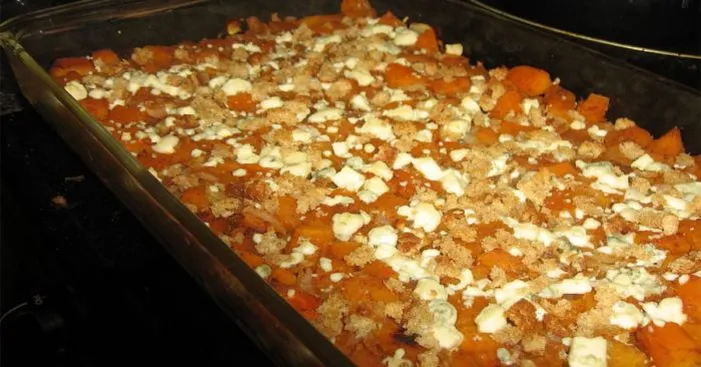
Ingredients:
- 3 lbs of squash.
- 30 chestnuts.
- 1 pinch of nutmeg powder.
- 1 cup of milk.
- 4 eggs.
- 1tsp of salt & 1 tsp of pepper.
Preparation:
- Peel your chestnuts then crush them into smaller pieces.
- Take the skin of your squash off and dice it using a knife then steam the small pieces for about 20 minutes.
- You can also bake the squash, in this scenario you just slice the squash then cover the slices in aluminum foil then bake them for 25 minutes.
- Now that your squash pieces are soft, go ahead and turn them into puree using a fork or a blender.
- In a bowl, mix the milk and the eggs and stir.
- Add the nutmeg powder, salt, and pepper, and keep mixing.
- Preheat the oven to 350°F (180°C).
- Now add the squash puree and the chestnut pieces to the milk mixture.
- Butter up an oven tray, then pour the mixture you made and make sure it’s spread evenly.
- Place the tray in the oven and let it cook for 45 minutes, or until the surface of the gratin becomes brown.
- Serve it for 4 people with feta cheese and other crushed nuts on top, enjoy!
Buying chest nuts:
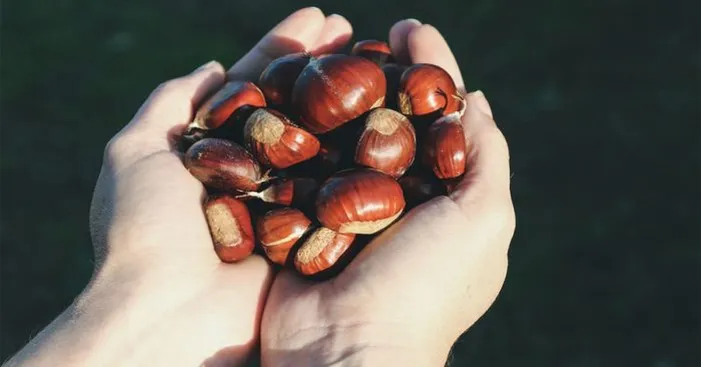
In the market, you can find all sorts of chest nuts raw, peeled, roasted, packed, frozen…
If you buy fresh chest nuts, choose the ones that are tightly packed and that look big with bright brown color and no bruises.
Also, good chest nuts must feel heavy and shouldn’t feel empty on the inside.
You can shake the chest nut and make sure that the fruit inside isn’t moving or making sounds as that is a sign of dryness.
The hard outer shell must have no holes as that is the only line of defense against parasites.
Soak your chestnuts in water and make sure you throw away those that float as they only do that when they’re hollow.
Storing chest nuts:
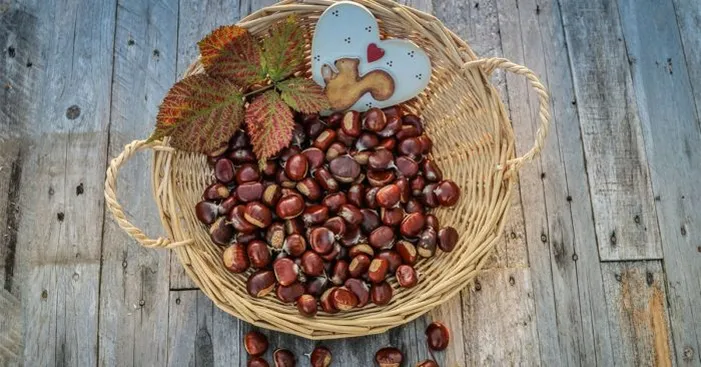
Depending on the type of chest nuts you are buying, the storing way may be as follows:
The best way to store chest nuts is to take them out of their package and put them in an airtight container away from moisture and insects.
You can place the chest nuts container in the fridge and that would make them last for a whole month.
However, if you want to store them for a longer period you can simply keep them in the freezer for up to 6 months.
Peeled and cooked chest nuts can be kept in the fridge for up to 4 days or frozen for up to 9 months.
